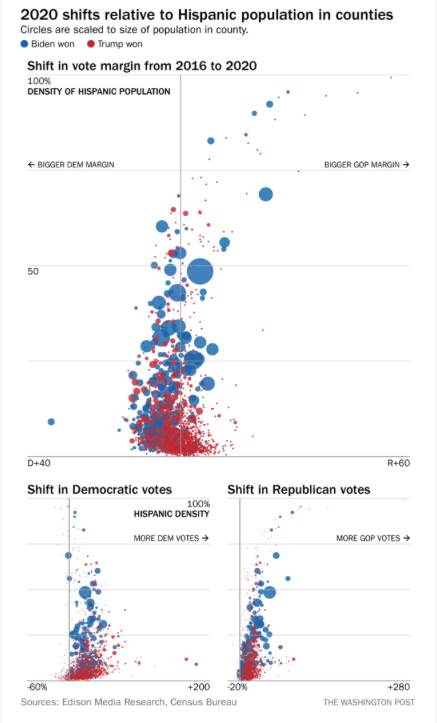
"How To Read This Chart", (inset) Phillip Bump, national correspondent of The Washington Post
Credit: Courtesy of The Washington PostThe Washington Post has launched a newsletter that dives into the data behind the week's major news and guides readers through ways visualisations could be improved.
"How To Read This Chart" is penned by popular national correspondent Philip Bump who analyses charts about economics, pop culture or politics. The Washington Post is focusing on newsletters as a way to diversify its news offering and meet different needs.
The first edition on 11 December saw Bump dive into what he dubbed "the 2020 tornado" - the shift in the presidential vote in each US county from 2016 to 2020.
Through humour and simple explanations, he demonstrates how the most heavily Hispanic counties shifted toward Trump. This is put into context by the renewed debate about the solidity of Hispanic support for Democrats making the news.

Courtesy of The Washington Post
"Charts and visualisations are relegated to specific types of articles instead of being a tool like photographs that can better illustrate a story," says Bump in an email to Journalism.co.uk.
"By focusing specifically on how charts are used well and amplifying the process for making a good chart, the hope is that both audience and the creator will feel more comfortable in presenting data visually."
Even reporters can get confused by charts, let alone audiences. But Bump spends a lot of time in his day job creating visualisations centred around the news agenda. The idea for the newsletter is to create an accessible way for people to learn a bit about how and why charts were made.
"The workflow for the newsletter is fairly simple," Bump continues. "I find a chart that I think is interesting or informative and I explain why. Then I sandwich that between dumb jokes and semi-cogent ramblings and throw it in the oven."
The Post opted for newsletters primarily for the consistency of delivery it presents, in a way that does not overlap with the weekly column in the paper or a weekly digest on the site. Newsletters aim to appeal to a sense of community and continuity for readers.
Secondly, it is easier to adopt an informal approach in a newsletter. The wit and idiosyncrasies Bump's readers have known to love are all on display here.
The first newsletter opens with: "I am one of those people who, at a social event where I don't know anyone, has no idea how to strike up a conversation."
And it ends with: "Anyway, it was nice to meet you. I don't really know how to end conversations at social events either, so sometimes I just awkwardly sort of leave —"
Free daily newsletter
If you like our news and feature articles, you can sign up to receive our free daily (Mon-Fri) email newsletter (mobile friendly).
Related articles
- Why DC Thomson's data journalists are keeping tabs on high street businesses
- Washington Post opinions editor David Shipley on gearing up for the US election
- Tips and advice for growing a Substack local newsletter
- Tackling new challenges for data journalism, with DC Thomson's Lesley-Anne Kelly and Ema Sabljak
- LinkedIn newsletters: are they what they are cracked up to be?









